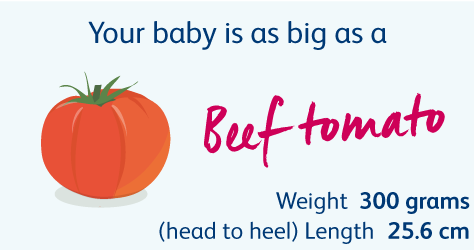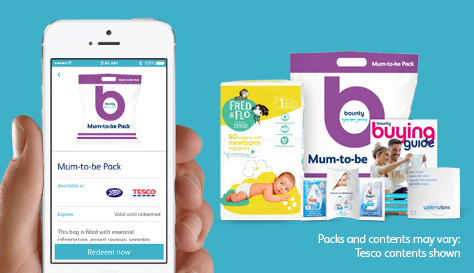What's happening in week 20 of your pregnancy
20 weeks into your pregnancy and you are half way there!
At a glance
- Your baby is now perfectly formed and probably turning somersaults!
- You might experience some aching as your bump grows and your womb stretches
- Try a pregnancy pillow for support if you feel uncomfortable when you sleep

From this week onwards your baby is measured from head to heel.
How big is my baby at 20 weeks pregnant?
By week 20, your baby will now measure around 16.5cm long, head to rump and around 25cm from head to heel. They are around the size of a large beef tomato and growing quickly!
Your baby's development
If space allows, they are still having fun turning somersaults, and perhaps still taking you by surprise as they do so.
Although they are mainly just growing bigger and stronger now, there are some key elements of their development going on as the nerves in their brain which control the senses are still forming, eventually enabling them to smell, see, hear, taste and touch.
They will also start producing Meconium in their bowel. This is a harmless mixture of amniotic fluid that your baby has swallowed, digestive secretion and dead skin cells that will form your baby’s first bowel movement after birth.
Around this time you will have your ‘anomaly scan’ where your baby will be measured to make sure their growth is on track. Major organs will be checked for proper development. And amniotic fluid, placenta location, and fetal heart rate will all be examined to be sure baby’s thriving. Your scan will also show the position of the placenta.
A low-lying placenta (where it attaches itself to the lower part of the womb) may sometimes be identified at the anomaly scan. Don’t be too worried as in 90% of cases, as your baby grows, your expanding uterus naturally pulls the placenta upwards away from your cervix. For some women, the placenta continues to lie in the lower part of the uterus after 20 weeks.
If your placenta is partially or completely blocking the womb opening at the end of pregnancy, this is known as known as '
placenta praevia' (pronounced 'preev-ee-ah').
This affects 1 in 200 births. However, if your placenta is shown to be covering the cervix at your anomaly scan another scan will be offered between 32-36 weeks to check whether its moved.
Did you know?
- By now your baby can hear your heartbeat and outside noises like music
- Your baby's hair is starting to grow
- Your baby is now formed and turning somersaults
- From 20 weeks onwards babies are measured from the top of the head to the heel
You at 20 weeks pregnant
You might experience some aching in your tummy as your bump continues to grow – this is due to the ligaments each side of your womb stretching as your baby gets bigger and bigger. It is perfectly normal, but as with everything, do mention it to your midwife if you are worried.
Some women develop pains in their pelvis called pregnancy-related pelvic girdle pain (PRGP) or symphysis pubis dysfunction (SPD) when pregnant (again, not dangerous, just uncomfortable) which can be treated with physio or support girdles.
Your bump might mean you are struggling to get comfy in bed at this stage too, and so you could be feeling tired because of interrupted sleep. You can buy specially shaped pregnancy pillows to help support your bump and enable you to get a good night's rest (many of these are also useful post-pregnancy for breastfeeding), or simply to offer you more support when you are sitting or chilling on the sofa.
Did you know?
- Pregnant women have less oxygen in their blood, which may explain 'baby brain,' or forgetfulness – although it’s not been proven and is generally thought to be linked to changes in the brain which occur in pregnancy
- Drink cranberry juice to help prevent urinary tract infections (UTIs)
- Pregnancy is the only time in life when you'll fall in love with someone you haven't met

Your FREE Mum-to-be pack is waiting in the Bounty app
Pack content varies by retailer


What to think about in week 20 of pregnancy
Now you’re at the half way point in your pregnancy, thought of your maternity leave may start to creep closer and closer.
But have you actually worked out the best time to start your maternity leave? Have you had the conversation with your employer? Now maybe the time to tie up all those loose ends and making sure you know what you need to know and get sorted.
It’s not an easy decision figuring out when to start your maternity leave. The decision can be made more difficult if you’re experiencing severe pregnancy symptoms or work in a physically demanding job, so continuing in your job towards the end of your pregnancy may feel unrealistic but you want to want to ensure you get to spend as much time as possible with the baby after it’s born.
To help you with your decision we’ve got the headline facts, alongside some advice on what to think about when choosing your leave date.
Dads have rights too! As do same-sex partners and civil partners have the same rights as all parents. If they have been with their current employer continuously for at least 26 weeks by the end of the 15th week before the baby is due, they are entitled to paternity leave.
There are two types of paternity leave: 1 or 2 weeks paid Ordinary Paternity Leave and up to 26 weeks paid Additional Paternity Leave (if mum decides to return to work). Your partner will need to take all their Ordinary Paternity Leave in one go, and it must end within 56 days of your baby being born.
Statutory Paternity Pay for eligible employees is either £148.68 a week or 90% of their average weekly earnings (whichever is lower).
If you decide to return to work before your maternity leave has ended, your partner could be able to take Additional Paternity Leave of between 2 and 26 weeks, depending on how much unused maternity leave you have left over. This leave can start 20 weeks after the birth if you choose to return to work, but must stop on your baby's first birthday.
At this halfway point of your pregnancy, you may also be starting to think about signing up to antenatal classes.
Wanting to understand what they are all about, how they can benefit you and what classes are available in your local area can seem a bit baffling, but antenatal classes can benefit you in many ways.
They aren't simply to teach you about breathing exercises and learning how to look after your baby once you arrive home – they are also a great opportunity to make the basics of how to make friends with other mums going through exactly the same mum-to-be (and then new mum) hurdles as you, and more importantly, at the exact same time you are facing them.
If you have pets you might be wondering how to best introduce them to your new baby when the time comes, or how to successfully designate certain areas of the house pet free! Of course, your animals should never be left alone with your baby, or have access to their pram or cot, but you can take steps to additionally protect your little one from inquisitive pets.
Nets that go over your Moses basket or cot are easily available on the high street, and baby gates have tons of uses which are not just restricted to keeping toddlers away from stairs!
Chat with your vet for professional advice on prepping your dog or cat for your new arrival – although as long as basic common sense and safety is applied, you should all manage just fine!
Found this helpful? Read more on..
Signs and symptoms at 20 weeks pregnant
Vaginal discharge
Increased vaginal discharge is a common pregnancy symptom. It’s usually nothing to worry about, but if the discharge changes in colour and you are experiencing any pain, get it checked out. Vaginal discharge is often sparked by hormonal changes, which is why you may notice it in greater quantities during pregnancy since it will increase until full-term you may want to try using panty liners. Despite this, it shouldn't have a strong smell or produce other symptoms so if it changes in colour, becomes heavy or thick, or has a strong odour it may be a sign of infection so speak to your healthcare professional.
Fainting and dizziness
This can be something you suffer with throughout your pregnancy or you may find it comes and goes. It is not an illness in its own right but literally a symptom to let you know something is not right in your body. By this stage of your pregnancy you will probably have been advised not to lay on your back to avoid your growing bump pressing on the vena cava blood vessel. Lying in this position can leave you feeling dizzy but a number of other things can also make you feel dizzy including anaemia, dehydration and low blood sugar levels. Research has shown that going to sleep on your back (after 28 weeks of pregnancy) also increases your risk of stillbirth. Don’t become anxious about this but do try to go to sleep on your side as the position we go to sleep in is the position we spend the longest amount of time in during the night.
Watch our video below on: Getting ready for your baby's arrival
Baby Name Search